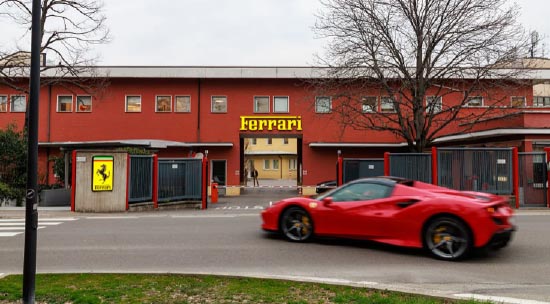Luxury carmaker Ferrari's shares suffered their worst trading day ever on Thursday (October 9) after the company updated its full-year and 2030 guidance and scaled back its electrification ambitions.

Analysts were disappointed with the new guidance, saying it fell short of expectations.
The Maranello, Italy-based sports car maker said at its Capital Markets Day (CMD) event that it expects net profit of at least 7.1 billion euros ($10.7 billion) this year, up from a previous forecast of over 7 billion euros.
Net revenue is expected to reach around 9 billion euros by 2030, and the company is targeting earnings before interest, taxes, depreciation, and amortization (EBITDA) of at least 3.6 billion euros by 2030.
Ferrari's Milan-listed shares plunged 16.1% before recovering some losses to close at 354 euros, down 15.4%. This was Ferrari's worst trading day since it went public on the Milan Stock Exchange in early 2016.
Shares listed on the New York Stock Exchange closed down 15% at $407.38 per share, their worst trading day since Ferrari went public in October 2015. The stock's previous biggest single-day drop was a 12.4% drop in February 2016.
The company's U.S.-listed shares, with a market capitalization of nearly $77 billion, have fallen about 4% this year.
Citi analysts said in a research note that Ferrari's outlook "is lower than the 'lower growth scenario' we projected in our CMD preview, which we believe reflects management's conservatism."
They added, "While the guidance is conservative, it implies limited operating leverage in future cycles, and therefore we believe there is some risk to both expected earnings per share and the near-term P/E ratio."
In a separate update, Ferrari said it is targeting a 2030 sports car lineup consisting of 40% internal combustion engine vehicles, 40% hybrids, and 20% fully electric vehicles.
Ferrari said the revised target, which follows its previous goal of 40% electric vehicle sales by the end of the decade, is based on a customer-centric approach, the current environment, and its expected evolution.
The shift comes as the Italian automaker unveiled the technology powering its first electric vehicle. Ferrari unveiled the production chassis and powertrain of the "Electrica" at a technology and innovation symposium and said deliveries of the model will begin in late 2026.
The completed car is expected to be launched at a world premiere next year.
"With the all-new Ferrari Electrica, we reaffirm our progressive will to combine technological discipline, design creativity, and manufacturing craftsmanship," said John Elkann, Ferrari's executive chairman, in a statement.
Electric Ambitions
Several global automakers have lowered their electric vehicle sales targets in recent months, citing a lack of affordable models, a slower-than-expected rollout of charging stations, and intense competition.
Sweden's Volvo Cars, for example, abandoned its much-touted plan to sell only electric vehicles by 2030, saying last September that it needed to be "pragmatic and flexible" in the face of changing market conditions.
Ferrari's current active customer base has grown to 90,000, a 20% increase compared to 2022. The company also said it plans to launch an average of four new models annually between 2026 and 2030.
JPMorgan analysts are bullish on Ferrari following the announcement of its "2030 Strategic Plan."
"We are highly confident in management's ability to execute on its long-term plan, given the well-documented trend that demand currently significantly outstrips supply," JPMorgan analysts said in a research note Thursday.
"We also estimate that the company is benefiting from CEO Benedetto Vigna's leadership style, which challenges the company to leverage collaboration to increase the pace of innovation. The upcoming supercar is also likely to be accretive to profits," they added.




